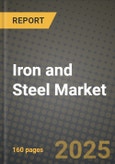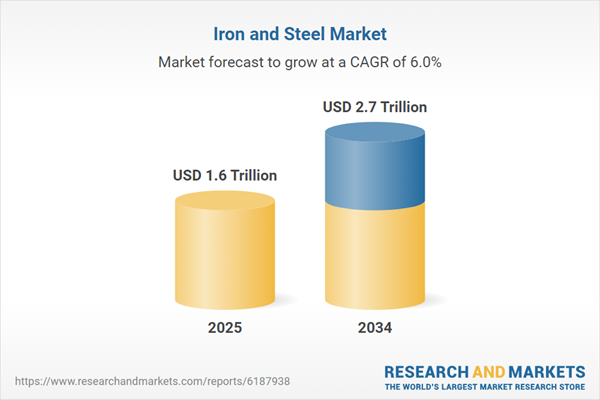The Iron and Steel Market represents one of the most critical sectors in the global industrial economy, serving as the backbone for infrastructure, construction, transportation, energy, and manufacturing. Iron is the raw material used to produce steel - an alloy of iron and carbon - valued for its strength, durability, and versatility. From skyscrapers to pipelines and automobiles to appliances, steel is essential in shaping modern civilization. The industry operates through a mix of integrated steel plants and electric arc furnaces, processing raw materials like iron ore and scrap metal. As nations ramp up investment in infrastructure, renewable energy, and urban expansion, the iron and steel sector continues to be a cornerstone of economic development worldwide.
The iron and steel market experienced steady growth amid fluctuating commodity prices and evolving global trade dynamics. Countries like India and Vietnam saw a production surge as new capacities came online to meet domestic infrastructure demand. Green steel initiatives gained traction, particularly in Europe and North America, where carbon tariffs and ESG pressures drove investments in hydrogen-based and low-carbon steelmaking. Meanwhile, China introduced stricter emission regulations, causing temporary output constraints but boosting the transition toward greener technologies. Major producers like ArcelorMittal, POSCO, and Baowu Steel launched decarbonization roadmaps. Despite some volatility in iron ore prices and energy costs, overall demand remained strong, supported by real estate recovery, auto production rebound, and increased government spending on public works.
The iron and steel market is poised for transformation driven by sustainability, digitization, and regional diversification. Governments will continue to tighten environmental compliance, prompting wider adoption of electric arc furnaces and carbon capture technologies. Demand for 'green steel' will grow, fueled by automakers, construction firms, and financial institutions prioritizing low-emission supply chains. Digital twin technology, predictive maintenance, and AI-integrated quality control will modernize plant operations. Recycling will play a larger role as scrap availability improves and circular economy models scale. Trade patterns may shift further due to geopolitical tensions and supply chain localization. Overall, the industry will strike a balance between scaling production and reducing its environmental impact, ensuring long-term resilience and competitiveness.
Key Insights: Iron and Steel Market
- The analyst highlights the rise of green steel production using hydrogen-based direct reduction and electric arc furnaces, as producers race to meet decarbonization targets set by governments and ESG-minded investors.
- Digital transformation in steelmaking is trending, with advanced sensors, AI-driven quality control, and predictive analytics improving production efficiency, safety, and downtime management in modern mills.
- According to the analyst, regional diversification of steel production is increasing, as countries invest in local capacity to reduce import dependence and build resilient domestic supply chains.
- Scrap steel recycling is gaining momentum as an environmentally friendly and cost-effective raw material source, especially in developed economies focusing on circular manufacturing practices.
- Green building certifications and sustainable infrastructure projects are influencing demand for low-carbon steel products that meet modern environmental standards in construction and engineering.
- The analyst identifies global infrastructure development - including railways, bridges, airports, and affordable housing - as a major demand driver for structural steel and rebar in emerging and mature economies alike.
- Rising automobile production, including electric vehicles, is pushing demand for specialized steel grades used in lightweight frames, safety components, and battery enclosures, says the analyst.
- The analyst notes that policy support, such as government-backed steel capacity expansion programs and trade protection measures, is fueling domestic production in key markets like India, Brazil, and Turkey.
- The transition to renewable energy is boosting consumption of steel in wind turbine structures, solar panel frames, and power grid infrastructure, linking steel demand to clean energy growth.
- The analyst highlights rising energy costs and raw material volatility - particularly coal and iron ore - as key challenges impacting profitability and operational stability for steelmakers globally.
- According to the analyst, tightening emission regulations and pressure to decarbonize pose significant capital investment burdens, especially for legacy integrated steel plants in developing regions.
Iron and Steel Market Segmentation
By Type
- Iron
- Steel
By Production Technology
- Basic Oxygen Furnace
- Electric Arc Furnace
- Open Hearth
- Other Production Technologies
By End User
- Building and Construction
- Automotive and Transportation
- Heavy Industry
- Consumer Goods
Key Companies Analysed
- ArcelorMittal S.A.
- Nippon Steel Corporation
- China BaoWu Steel Group Corporation Limited
- HBIS Group
- Pohang Iron and Steel Company
- Tata Steel Limited
- Steel Authority of India Limited
- Nucor Corporation
- JFE Steel Corporation
- Steelmor Industries
- Ezz Steel
- GKN Powder Metallurgy
- Beshay Steel Group
- Scaw Metals Group
- Libyan Iron and Steel Company
- POSCO Holdings Inc.
- Ansteel Group Corporation
- JSW Steel Limited
- Hebei Iron and Steel Group
- Wuhan Iron and Steel Group
- Baoshan Iron & Steel Co. Ltd.
- Shagang Group
- Shandong Iron and Steel Group
- Evraz plc
- Gerdau S.A.
- ThyssenKrupp AG
- United States Steel Corporation
- Hyundai Steel Company
- Maanshan Iron & Steel Company Limited
- Valin Group
Iron and Steel Market Analytics
The report employs rigorous tools, including Porter’s Five Forces, value chain mapping, and scenario-based modeling, to assess supply-demand dynamics. Cross-sector influences from parent, derived, and substitute markets are evaluated to identify risks and opportunities. Trade and pricing analytics provide an up-to-date view of international flows, including leading exporters, importers, and regional price trends.Macroeconomic indicators, policy frameworks such as carbon pricing and energy security strategies, and evolving consumer behavior are considered in forecasting scenarios. Recent deal flows, partnerships, and technology innovations are incorporated to assess their impact on future market performance.
Iron and Steel Market Competitive Intelligence
The competitive landscape is mapped through proprietary frameworks, profiling leading companies with details on business models, product portfolios, financial performance, and strategic initiatives. Key developments such as mergers & acquisitions, technology collaborations, investment inflows, and regional expansions are analyzed for their competitive impact. The report also identifies emerging players and innovative startups contributing to market disruption.Regional insights highlight the most promising investment destinations, regulatory landscapes, and evolving partnerships across energy and industrial corridors.
Countries Covered
- North America - Iron and Steel market data and outlook to 2034
- United States
- Canada
- Mexico
- Europe - Iron and Steel market data and outlook to 2034
- Germany
- United Kingdom
- France
- Italy
- Spain
- BeNeLux
- Russia
- Sweden
- Asia-Pacific - Iron and Steel market data and outlook to 2034
- China
- Japan
- India
- South Korea
- Australia
- Indonesia
- Malaysia
- Vietnam
- Middle East and Africa - Iron and Steel market data and outlook to 2034
- Saudi Arabia
- South Africa
- Iran
- UAE
- Egypt
- South and Central America - Iron and Steel market data and outlook to 2034
- Brazil
- Argentina
- Chile
- Peru
Research Methodology
This study combines primary inputs from industry experts across the Iron and Steel value chain with secondary data from associations, government publications, trade databases, and company disclosures. Proprietary modeling techniques, including data triangulation, statistical correlation, and scenario planning, are applied to deliver reliable market sizing and forecasting.Key Questions Addressed
- What is the current and forecast market size of the Iron and Steel industry at global, regional, and country levels?
- Which types, applications, and technologies present the highest growth potential?
- How are supply chains adapting to geopolitical and economic shocks?
- What role do policy frameworks, trade flows, and sustainability targets play in shaping demand?
- Who are the leading players, and how are their strategies evolving in the face of global uncertainty?
- Which regional “hotspots” and customer segments will outpace the market, and what go-to-market and partnership models best support entry and expansion?
- Where are the most investable opportunities - across technology roadmaps, sustainability-linked innovation, and M&A - and what is the best segment to invest over the next 3-5 years?
Your Key Takeaways from the Iron and Steel Market Report
- Global Iron and Steel market size and growth projections (CAGR), 2024-2034
- Impact of Russia-Ukraine, Israel-Palestine, and Hamas conflicts on Iron and Steel trade, costs, and supply chains
- Iron and Steel market size, share, and outlook across 5 regions and 27 countries, 2023-2034
- Iron and Steel market size, CAGR, and market share of key products, applications, and end-user verticals, 2023-2034
- Short- and long-term Iron and Steel market trends, drivers, restraints, and opportunities
- Porter’s Five Forces analysis, technological developments, and Iron and Steel supply chain analysis
- Iron and Steel trade analysis, Iron and Steel market price analysis, and Iron and Steel supply/demand dynamics
- Profiles of 5 leading companies - overview, key strategies, financials, and products
- Latest Iron and Steel market news and developments
Additional Support
With the purchase of this report, you will receive:- An updated PDF report and an MS Excel data workbook containing all market tables and figures for easy analysis.
- 7-day post-sale analyst support for clarifications and in-scope supplementary data, ensuring the deliverable aligns precisely with your requirements.
- Complimentary report update to incorporate the latest available data and the impact of recent market developments.
This product will be delivered within 1-3 business days.
Table of Contents
Companies Mentioned
- ArcelorMittal S.A.
- Nippon Steel Corporation
- China BaoWu Steel Group Corporation Limited
- HBIS Group
- Pohang Iron and Steel Company
- Tata Steel Limited
- Steel Authority of India Limited
- Nucor Corporation
- JFE Steel Corporation
- Steelmor Industries
- Ezz Steel
- GKN Powder Metallurgy
- Beshay Steel Group
- Scaw Metals Group
- Libyan Iron and Steel Company
- POSCO Holdings Inc.
- Ansteel Group Corporation
- JSW Steel Limited
- Hebei Iron and Steel Group
- Wuhan Iron and Steel Group
- Baoshan Iron & Steel Co. Ltd.
- Shagang Group
- Shandong Iron and Steel Group
- Evraz PLC
- Gerdau S.A.
- ThyssenKrupp AG
- United States Steel Corporation
- Hyundai Steel Company
- Maanshan Iron & Steel Company Limited
- Valin Group
Table Information
| Report Attribute | Details |
|---|---|
| No. of Pages | 160 |
| Published | October 2025 |
| Forecast Period | 2025 - 2034 |
| Estimated Market Value ( USD | $ 1.6 Trillion |
| Forecasted Market Value ( USD | $ 2.7 Trillion |
| Compound Annual Growth Rate | 6.0% |
| Regions Covered | Global |
| No. of Companies Mentioned | 30 |









